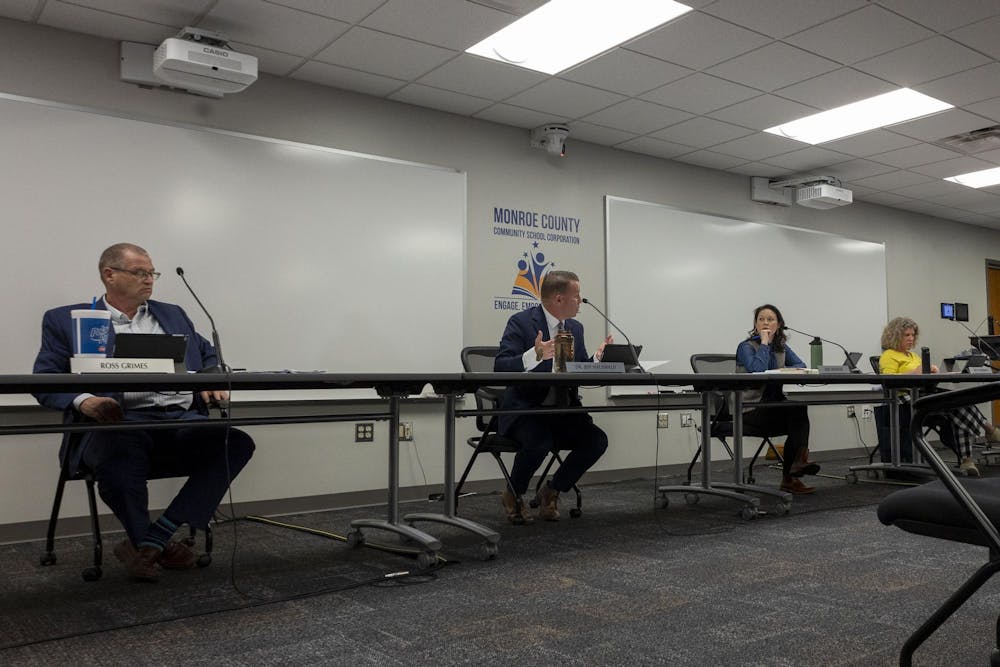While the Monroe County Community School Corporation’s board of trustees made few official decisions at its March meeting, they did commit to one thing. No matter what, they’d take a vote on redistricting proposals at the next meeting, scheduled April 23.
The issue of redistricting in county schools has been under consideration for months. The conversation started with a proposed elementary school merger meant to balance socioeconomic status across schools, but when the community protested, board members suggested broader redistricting attempts.
Elementary schools in the district face vast differences in socioeconomic status, Board President April Hennessey said. This means some schools don’t have the same resources as others; specifically, parents and faculty. For example, teachers are more likely to leave schools with a higher free or reduced lunch population. In Bloomington, that could include schools like Fairview Elementary and Templeton Elementary.
“We've tried to do other things to mitigate those issues that we see,” Hennessey said. “But what we know is that when we have balanced buildings and balanced classrooms, it is better for everyone, and there's a greater resource pool to draw from.”
Redistricting could also help even out the number of students per school, Hennessey said.
This isn’t the first time the MCCSC has considered redistricting. There have been two major redistricting attempts in the last thirty years. As the board considers redistricting, what can these attempts tell us about what the MCCSC is looking at going forward?
History of redistricting
Board members consistently cite the same year when discussing redistricting: 1997. This year is considered the last comprehensive attendance zone redistricting, and it was meant to balance enrollment at elementary and high schools. Jackson Creek Elementary School was set to open the following year, meaning the district had to determine which students would go there. The district also had to equalize enrollment between high schools, with nearly 450 more students at Bloomington High School South than at Bloomington High School North.
When the board was looking at redistricting, the district wanted to minimize bus rides, prioritize neighborhood schools and consider diversity and socioeconomic status, according to a 2019 board meeting presentation.
The biggest change was the addition of Jackson Creek, but the high school attendance dividing line was also shifted to the center of town, and a few neighborhoods changed schools.
The district also underwent redistricting in 2005. The district doesn’t consider it comprehensive, referring to 1997 as the last comprehensive redistricting. However, former board president Sue Wanzer, who led the school board at the time, disagrees. This attempt involved parents and teachers in the process, she said, and the board produced multiple rezoning ideas.
Parents and teachers worked together to form a realignment task force. Their focus was on keeping neighborhoods together and transportation time low. They wanted to create cohorts of students and feeder schools, so groups of students would stay together transitioning between schools. Socioeconomic diversity was considered “when appropriate.”
Another goal in 2005 was to keep the community informed. The MCCSC created an email link on their website where people could send in questions or concerns about the process.
This redistricting largely affected individual neighborhoods. Over 20 neighborhoods changed zones, and the high school line was moved again, this time to south of BHS South due to population expansion in southern Bloomington, according to Wanzer and past Herald-Times articles.
What issues keep coming up?
Every time the district has moved to redistrict, there’s always been pushback from the community. The biggest barrier to redistricting is always community support, Hennessey said.
Steve Hinnefeld used to cover education for the Herald-Times. He remembers being shocked by the “vociferous” opposition.
“People were really, really threatened by the idea,” Hinnefeld said.
Wanzer recalls parents “screaming and yelling” in 2005. A new housing development was being built, and people thought the developers had paid off the board to redistrict schools to benefit the development.
“People wanted to see our bank records to see if we had taken bribes,” Wanzer said. “Two of those parents said, ‘I'll never do anything like this again.’”
Members of the community who’ve shown up to board meetings are overwhelmingly against the merger. However, many who spoke out against the merger are for redistricting.
From Hinnefeld’s perspective, people agree with redistricting, but they think their own house won’t be redistricted. Once there are more solid plans, opinions may change.
The issue of “neighborhood schools” has also persisted throughout the years. One major worry public commenters have brought up is transportation. Students may not be able to walk to school, and parents may not be able to drop them off.
However, the focus of this attempt is on balancing socioeconomic status in the district, which directly conflicts with keeping neighborhood schools. Most low-income families live in the same areas, according to Wanzer, so neighborhoods will have to split up if the district wants to distribute resources evenly.
Hinnefeld agrees.
“Neighborhood schools, it becomes code for ‘I want my kids to go to school with kids who have similar family backgrounds’,” Hinnefeld said. “Neighborhoods are socioeconomically segregated. There are wealthy neighborhoods and there are poor neighborhoods, or neighborhoods where it's expensive to live and neighborhoods where it isn't expensive to live.”
After both attempts, there was a push to redistrict more often. The best practice is to redistrict every 10 years, Hennessey said. Population density changes. In the past 20 years, she said, the housing landscape has changed so much that it’s time to take a look at balancing schools.
But it’s not that simple, Hinnefeld said. It’s easier to not redraw district lines than to redistrict. As a grandparent to a former Fairview Elementary student, he sees both sides of the issue.
“In a liberal city like Bloomington, we should not be supporting segregated schools in any way. This is not a place where people should be hoarding opportunities for themselves,” Hinnefeld said. “But on the other hand, we like our neighborhood school the same way other people do.”




